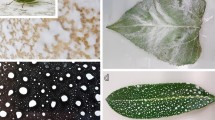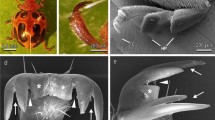Abstract
Tarsal substrate adhesion in insects is based on the effect of a thin film of liquid in the contact zone, which is deposited as droplets on the surface an insect has walked on, but as yet, little is known about the chemical composition of the liquid. In the present study, interference reflection microscopical images of the tarsal contact and footprints of Gastrophysa viridula (Coleoptera: Chrysomelidae) are depicted and the chemical composition of tarsal liquids and cuticular components are investigated by means of solid-phase microextraction and solvent extraction of whole beetles and footprints. Based on this comparative methodical approach, we are first to provide evidence from direct sampling for the chemical congruence of cuticular lipids and tarsal liquid in beetles. Furthermore, differences resulting from the applied sampling techniques are assessed and advantages of the respective methods are discussed.




Similar content being viewed by others
References
Aitchison J (1986) The statistical analysis of compositional data: monographs in statistics and applied probability. Chapmann and Hall, London
Arthur CL, Pawliszyn J (1990) Solid phase microextraction with thermal desorption using fused silica optical fibers. Anal Chem 62:2145–2148
Attygalle AB, Aneshansley DJ, Meinwald J, Eisner T (2000) Defense by foot adhesion in a chrysomelid beetle (Hemisphaerota cyanea): characterization of the adhesive oil. Zoology 103:1–6
Betz O (2002) Performance and adaptive value of tarsal morphology in rove beetles of the genus Stenus (Coleoptera, Staphylinidae). J Exp Biol 205:1097–1113
Betz O (2003) Structure of the tarsi in some Stenus species (Coleoptera, Staphylinidae): external morphology, ultrastructure, and tarsal secretion. J Morph 255:24–43
Betz O, Kölsch G (2004) The role of adhesion in prey capture and predator defence in arthropods. Arthropod Struct Dev 33:3–30
Bullock JMR, Drechsler P, Federle W (2008) Comparison of smooth and hairy attachment pads in insects: friction, adhesion and mechanisms for direction-dependence. J Exp Biol 211:3333–3343
Carlson DA, Bernier UR, Sutton BD (1998) Elution patterns from capillary GC for methyl-branched alkanes. J Chem Ecol 24:1845–1865
Deroe C, Pasteels JM (1982) Distribution of adult defense glands in chrysomelids (Coleoptera: Chrysomelidae) and its significance in the evolution of defense mechanisms within the family. J Chem Ecol 8:67–82
Doolittle RE, Proveaux AT, Alborn HT, Heath RR (1995) Quadrupole storage mass spectrometry of mono- and dimethylalkanes. J Chem Ecol 21:1677–1695
Drechsler P, Federle W (2006) Biomechanics of smooth adhesive pads in insects: influence of tarsal secretion on attachment performance. J Comp Physiol A 192:1213–1222
Eggenberger F, Heilporn S, Daloze D, Pasteels JM (1994) Sexual dimorphism in the lipid fraction of the defensive secretion of Gastrophysa viridula (Coleoptera: Chrysomelidae). Experientia 50:766–770
Eltz T (2006) Tracing pollinator footprints on natural flowers. J Chem Ecol 32:907–915
Federle W, Riehle M, Curtis ASG, Full RJ (2002) An integrative study of insect adhesion: mechanics and wet adhesion of pretarsal pads in ants. Integr Comp Biol 42:1100–1106
Federle W, Baumgartner W, Hölldobler B (2004) Biomechanics of ant adhesive pads: frictional forces are rate- and temperature-dependent. J Exp Biol 206:67–74
Federle W, Barnes WJP, Baumgartner W, Drechsler P, Smith JM (2006) Wet but not slippery: boundary friction in tree frog adhesive toe pads. J R Soc Interface 3:689–697
Francis GW, Veland K (1981) Alkylthiolation for the determination of double-bond position in linear alkenes. J Chromatogr 219:379–384
Geiselhardt S, Jakobschy D, Ockenfels P, Peschke K (2008) A sex pheromone in the desert tenebrionid beetle Parastizopus armaticeps. J Chem Ecol 34:1065–1071
Gorb SN (2001) Attachment devices of insect cuticle. Kluwer, Dordrecht
Hasenfuss I (1977) Die Herkunft der Adhäsionsflüssigkeit bei Insekten. Zoomorphology 87:51–64
Howard RW, Blomquist GJ (1982) Chemical ecology and insect biochemistry of insect hydrocarbons. Annu Rev Entomol 27:149–172
Howard RW, Blomquist GJ (2005) Ecological, behavioral, and biochemical aspects of insect hydrocarbons. Annu Rev Entomol 50:371–393
Ishii S (1987) Adhesion of a leaf feeding ladybird Epilachna vigintioctomaculta (Coleoptera: Coccinellidae) on a vertically smooth surface. Appl Entomol Zool 22:222–228
Jiao Y, Gorb S, Scherge M (2000) Adhesion measured on the attachment pads of Tettigonia viridissima (Orthoptera, Insecta). J Exp Biol 203:1887–1895
Kosaki A, Yamaoka R (1996) Chemical composition of footprints and cuticula lipids of three species of lady beetles. Jpn J Appl Entomol Zool 40:47–53
Lockey KH (1980) Insect cuticular hydrocarbons. Comp Biochem Physiol B 65:457–462
Lockey KH (1985) Insect cuticular lipids. Comp Biochem Physiol B 81:263–273
McFarlane JS, Tabor D (1950) Adhesion of solids and the effect of surface films. Proc R Soc Lond A 202:224–243
Monnin T, Malosse C, Peeters C (1998) Solid-phase microextraction and cuticular hydrocarbon differences related to reproductive activity in queenless ant Dinoponera quadriceps. J Chem Ecol 24:473–490
Nelson DR, Sukkestad DR (1970) Normal and branched aliphatic hydrocarbons from eggs of the tobacco hornworm. Biochemistry 9:4601–4611
Nelson DR, Sukkestad DR, Zaylskie RG (1972) Mass spectra of methyl-branched hydrocarbons from eggs of the tobacco hornworm. J Lipid Res 13:413–421
Nelson DR, Adams TS, Fatland CL (2003) Hydrocarbons in the surface wax of eggs and adults of the Colorado potato beetle, Leptinotarsa decemlineata. Comp Biochem Physiol B 134:447–466
Nikolova N, Rezanka T, Nikolova-Damyanova B, Kalushkov P (1999) Hydrocarbons in adult Chrysomela vigintipunctata (Scopoli) (Coleoptera: Chrysomelidae). Comp Biochem Physiol B 123:67–77
Peterson MA, Dobler S, Larson EL, Juárez D, Schlarbaum T, Monsen KJ, Francke W (2007) Profiles of cuticular hydrocarbons mediate male mate choice and sexual isolation between hybridising Chrysochus (Coleoptera: Chrysomelidae). Chemoecology 17:87–96
Pomonis JG, Nelson DR, Fatland CL (1980) Insect hydrocarbons. 2. Mass spectra of dimethylalkanes and the effect of the number of methylene units between groups on fragmentation. J Chem Ecol 6:965–972
Scribe P, Guezennec J, Dagaut J, Pepe C, Saliot A (1988) Identification of the position and the stereochemistry of the double bond in monounsaturated fatty acid methyl esters by gas chromatography/mass spectrometry of dimethyl disulfide derivatives. Anal Chem 60:928–931
Steiger S, Peschke K, Francke W, Müller JK (2007) The smell of parents: breeding status influences cuticular hydrocarbon pattern in the burying beetle Nicrophorus vespilloides. Proc R Soc Lond B 274:2211–2220
Stork NE (1980) A scanning electron microscope study of tarsal adhesive setae in the Coleoptera. Zool J Linn Soc 68:173–306
Sugawara F, Kobayashi A, Yamashita K, Matsuda K (1978) Identification of octadecyl acetate and (Z)-11-eicosenyl acetate, major components of the defensive secretion of Gastrophysa atroceanea Motschulsky. Agric Biol Chem 42:689–695
Sugeno W, Hori M, Matsuda K (2006) Identification of the contact sex pheromone of Gastrophysa atrocyanea (Coleoptera: Chrysomelidae). Appl Entomol Zool 41:269–276
Tentschert J, Bestmann H-J, Heinze J (2002) Cuticular compounds of workers and queens in two Leptothorax ant species—a comparison of results obtained by solvent extraction, solid sampling, and SPME. Chemoecology 12:15–21
Voigt D, Schuppert JM, Dattinger S, Gorb SN (2008) Sexual dimorphism in the attachment ability of the Colorado potato beetle Leptinotarsa decemlineata (Coleoptera: Chrysomelidae) to rough substrates. J Insect Physiol 54:765–776
Vötsch W, Nicholson G, Müller R, Stierhof Y-D, Gorb S, Schwarz U (2002) Chemical composition of the attachment pad secretion of the locust Locusta migratoria. Insect Biochem Mol Biol 32:1605–1613
Walker G (1993) Adhesion to smooth surfaces by insects—a review. Int J Adhes Adhes 13:3–7
Walker G, Yule AB, Ratcliffe J (1985) The adhesive organ of the blowfly, Calliphora vomitoria: a functional approach (Diptera: Calliphoridae). J Zool Lond A 205:297–307
Wilms J, Eltz T (2008) Foraging scent marks of bumblebees: footprint cues rather than pheromone signals. Naturwissenschaften 95:149–153
Zhang Z, Pawliszyn J (1993) Headspace solid-phase microextraction. Anal Chem 65:1843–1852
Acknowledgments
We thank Klaus-Günter Collatz and co-workers for useful comments on beetle breeding. Walter Federle kindly introduced SFG to the technique of interference reflection microscopy at his laboratory and let us use the pictures for this publication. Moreover, we would like to thank two anonymous reviewers for useful comments on an earlier draft of the paper.
Author information
Authors and Affiliations
Corresponding author
Rights and permissions
About this article
Cite this article
Geiselhardt, S.F., Geiselhardt, S. & Peschke, K. Comparison of tarsal and cuticular chemistry in the leaf beetle Gastrophysa viridula (Coleoptera: Chrysomelidae) and an evaluation of solid-phase microextraction and solvent extraction techniques. Chemoecology 19, 185–193 (2009). https://doi.org/10.1007/s00049-009-0021-y
Received:
Accepted:
Published:
Issue Date:
DOI: https://doi.org/10.1007/s00049-009-0021-y




